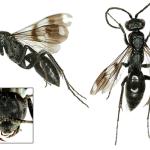This species reproduces by thelytokous parthenogenesis and so all individuals are female (Wahis & Durand, 2004). References to the male are based on misidentifications. The female is a rather large, black wasp with strongly bifasciate wings and thus superficially resembles a Dipogon species. However, the hind tibia has the pronounced scale-like teeth typical of Priocnemis.
Only known in Britain from two examples taken in the late nineteenth century: Lyndhurst, South Hants, 1893 and 1899, by Miss Chawnor.
Overseas it occurs in southern and eastern Europe, North Africa and the Levant (Wolf, 1972). The Netherlands, Belgium, France, Spain, Italy, Sardinia and the Czech Republic (Wahis, 2011)
Listed in the Appendix (Extinct) by Shirt (1987). Its status as a British insect is, at best, tenuous.
The British examples were found in a garden and on a race-course. Elsewhere it seems to be a species of sandy soils.
The two British examples were taken in August and September. On the continent it has a much longer flight period and can occur quite early in the spring.
No data available.
No data available. Priocnemis species in general make multilocular burrows, often utilising natural cavities.
No data available.
2019


